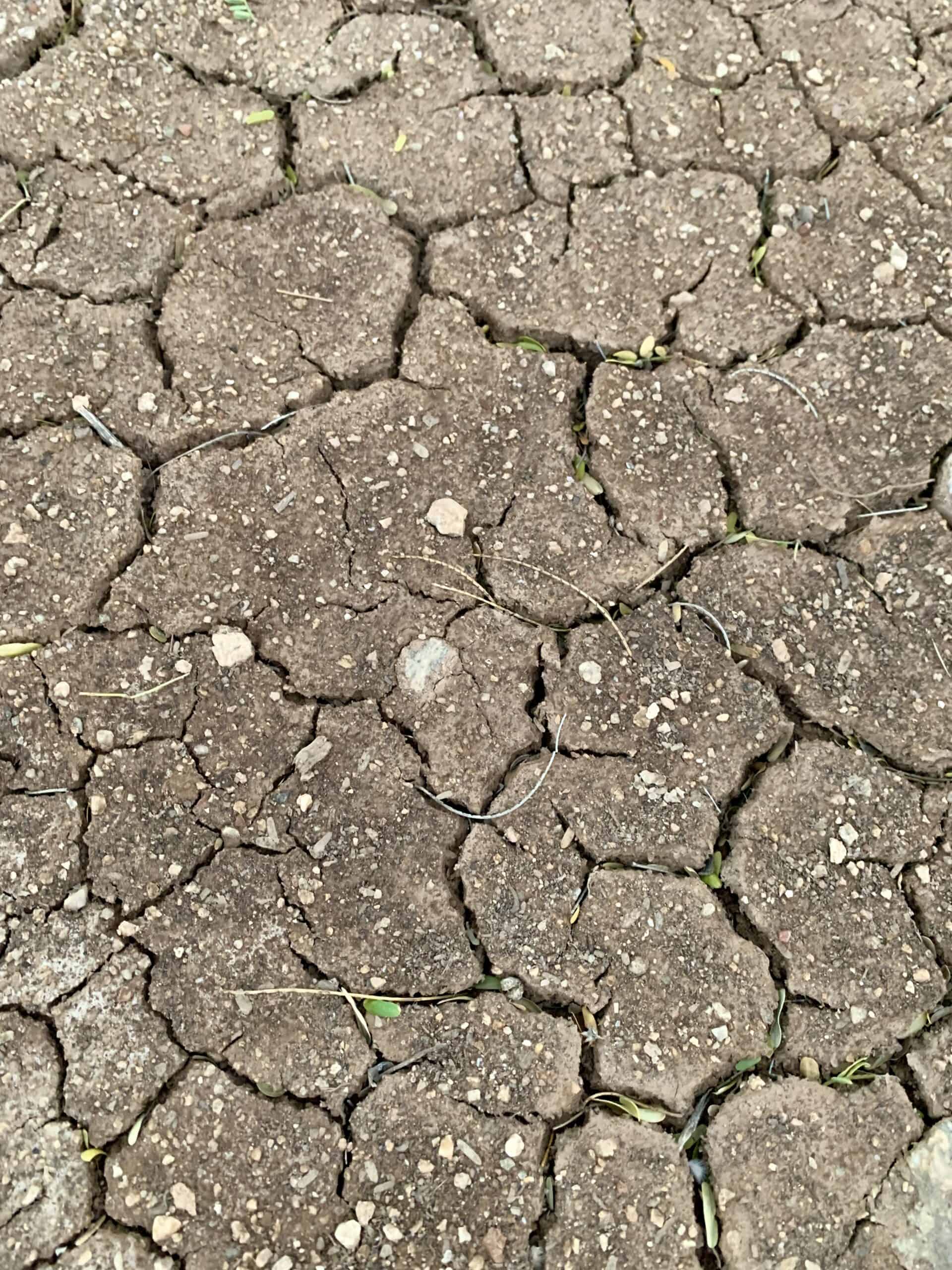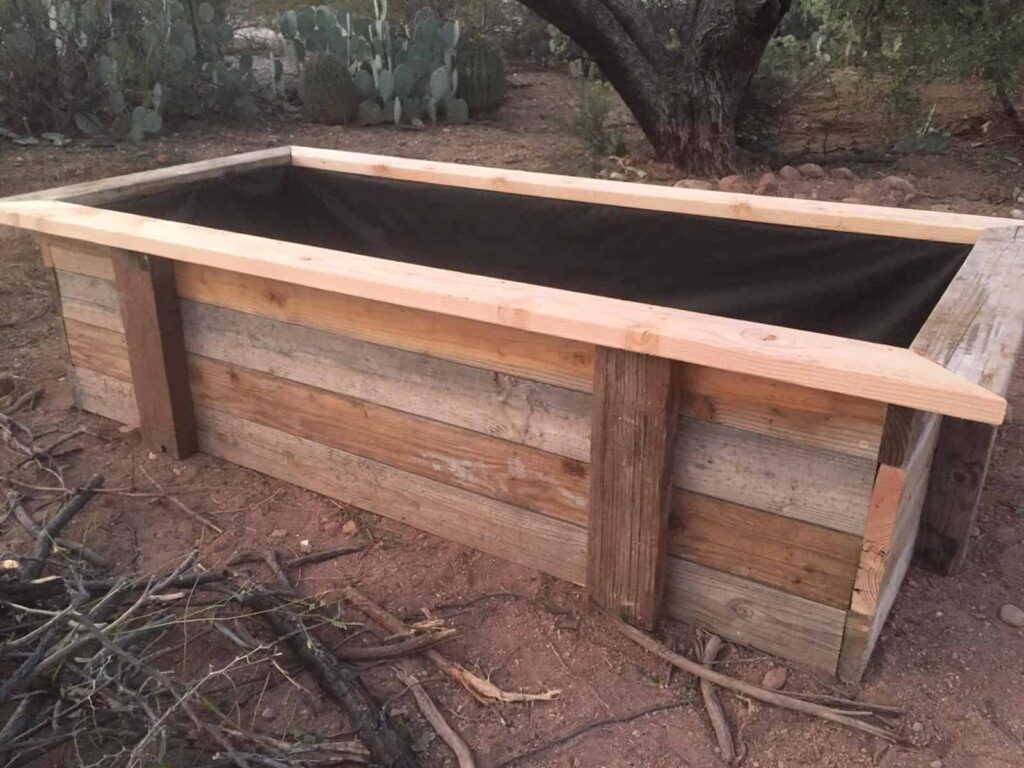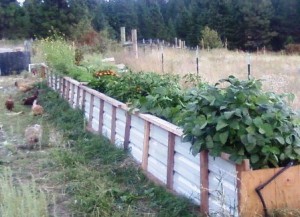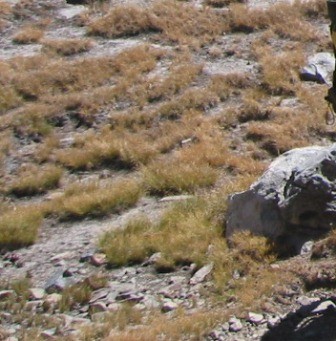Gardening in poor soil can be tough, making you wonder if it’s worth trying to start a garden there at all. It really depends. There may be ways around it; sometimes you can improve existing soil.
However, if it’s not an easy fix, you can plant in raised beds. The advantage of raised garden beds is you can fill them with high-quality soil from a nursery or home improvement center.
What is Poor Soil?
Poor soil is ground that doesn’t have the nutrients and structure needed to support healthy plant growth. The soil may consist of rocks, sand, or heavy clay. Or it may be dust or dirt without any substance to it.
In arid regions like the southwest, poor soil can also include caliche. This is a hard layer of soil cemented by calcium carbonate that can impede root growth. It is difficult to dig up.
How Do You Know if You Have Poor Soil?
Here are some ways to tell if your soil will be difficult to garden in.
- Heavy clay: Soil feels sticky and dense; water drains slowly
- Sandy texture: Soil feels gritty; it doesn’t hold moisture well. It also won’t hold nutrients well.
- Compaction: Soil is hard to dig or till, and roots cannot easily penetrate.
- Low organic matter: Soil lacks a rich, dark color indicating minimal decomposed plant material.
- Unusual pH levels: Soil is either too acidic or too alkaline, outside the 6.0 to 7.0 range ideal for most plants. You can buy a simple pH test kit to sample.
- Presence of caliche: A whitish layer in the soil profile indicates hard, cemented soil. You’ll know because it is very difficult to dig up and doesn’t look like soil.
- Poor structure: Soil does not form a loose ball; it falls apart when squeezed.
- Rocky and/or containing a lot of gravel: Large amounts of stones or gravel limit root development; soil provides nutrients to support plant growth while rocks do not
- Water pooling: Water sits on the surface for a long time, indicating poor drainage.
- Weeds: Certain hardy weeds thrive, suggesting soil imbalance.
It’s difficult to grow in poor soil. The good news is there are things you can do to enrich your soil. Learn more about poor soil and what you can do about it.

How Do You Start a Garden with Poor Soil
No matter how you describe it, if your soil is poor for gardening, you’ll have to be clever and work around it. There are two easy things you can do.
- Take a look at what you’ve got.
If you grab a handful of damp soil and squeeze it, what happens? If it holds together loosely, you may have a foundation to build on.
You can amend the soil with compost and manure and see what you have in another year or two.
On the other hand, if the soil either slips through your fingers like dust or forms a very firm clay ball, raised garden beds or lasagna gardening are probably better use of your time and money.

- Look for worms—yes, worms!
When you dig around in the soil, do you see any worms? Worms in the soil are an indicator of quality, so fewer worms in the soil can indicate a lack of nutrients. You may want to consider adding worm castings.
On the flip side, if you see many worms in your soil, you probably have high quality soil.
How Long Can You Wait?
Time and hard work spent creating a garden space will eventually pay off. It will usually take about 2 – 3 years of amending before you can turn poor soil into healthy fertile soil.
If you want good garden results this year or next, you can start growing some plants in a raised bed or containers while building soil in a larger area for a future garden.
Ways to Enrich Poor Soil
Soil amendment
This takes a few years and can include adding compost and manure to the soil. Planting cover crops and later tilling them into the soil as “green manure” incorporates substance and nutrients.
If you have space on your property, start a compost pile. You can work aged compost into soil to make it fertile to grow vegetables. If you lack space or don’t want to have an open-air compost, consider getting a compost tumbler. It makes composting easy.
Materials to till in
Dry leaves, weed-free plant material, seed-free kitchen vegetable/fruit scraps, used livestock bedding. They will eventually “compost in place.”
Some other materials to add in small amounts are sawdust/wood chips (will pull nitrogen out of soil if used too much), evergreen needles (will add acid), wood ashes (will add alkalinity and other minerals), and bone meal for calcium.
You can make your own calcium ash supplement by burning leftover meat bones after you’ve boiled them to stock. The resulting ash is a very available source of calcium and other minerals for your plants
Rural Living Today readers Fin and Sue told us that they built soil where they had a lot of rocks and sand. They used a combination of chicken tractors, composting, and lots of labor. Now, a few years later, their soil is very good for gardening!
Lasagna gardening/sheet composting
This type of gardening involves layering various materials on top of the ground and allowing them to compost in place.
Lasagna beds do not require tilling; usually turning the soil is sufficient between crops. A lasagna bed should be created right where you want your garden to be, as the layers will become the garden itself.
Each layer should be wet down well before adding the next layer of material. A good first layer is corrugated cardboard, which acts as a weed barrier.
Lay it right down on dirt, sod, gravel, whatever. Hose it down, then pile on the fillings.
Stack layers one to two feet high of any of the following materials: manure, compost, food scraps, dead leaves, wood chips–anything that will decompose.
Whenever you have more material, spread it on top and wet it down. Before long you’ll have a rich bed of great growing soil. You can get materials from lots of sources.
Place an ad in Craigslist or Freecycle for clean yard debris. Many people will drop it off instead of paying for removal.
Also ask farms and horse stables if you can take a load of free manure (if you have a truck available).
You may be able to get wood chip mulch from arborists or wire maintenance crews trimming trees on a city street.
In the fall, we like to drive around in the truck and snag bags of leaves off the curbside that have been set outside for trash – easy composting materials!
To help speed things along, we inoculate lasagna garden beds with a healthy dose of composting worms.
They will multiply quickly and the compost they create within the beds themselves is of the highest quality available. You can buy red worms online or you can sometimes find them in old leaf piles.
Mulch
Make sure you mulch. When I was younger and learning about gardening I did not understand why I kept hearing about mulch. But now that I am more experienced, I will not garden without it.
I use dead fall leaves, wood chips, spent straw, or pretty much whatever I can get my hands on.
Spread the mulch in a thick layer (a few inches) around your plants and in your beds.
This will not only help retain water but it will really help attract beneficial insects and worms.
When I build a new garden bed, I usually use the lasagna layering technique but I always make sure the top layer is a thick blanket of mulch for this reason.
Sometimes mulching can be the difference between sun-baked hard and compacted soil, and damp, loose and rich soil.

Raised beds and containers
This is the simplest in some ways, though it requires containment or shaping of beds. It involves bringing good soil in from somewhere else.
The simplest raised bed is good soil mounded on top of poor soil. Wood or rock frames can be used for edging, or you can just rake tumbling soil back into the mound as needed.
Raised beds constructed of wood, concrete blocks, straw bales, or other materials can be anywhere from a few inches to a few feet tall.
The height depends on the root depth of your plants as well as your physical comfort while gardening.
We love gardening in the waist-high raised bed built from lumber and corrugated metal roofing. It’s great because we can lean across to the center from either side without straining our backs.
We can pack a lot of intensively planted veggies in the 4’ x 40’ bed. To minimize the soil need, we filled the bed with tree branches in Horticulture fashion and capped them with topsoil.
As the branches decompose and the soil settles we’ll just top the bed off with our farm compost each year.
Transforming poor soil into usable soil
At our farm we use all these methods. We have a large garden patch in an area where we amended already-good soil with manure and green compost just for good measure.
A lasagna bed was layered in another area.
We use some low raised beds for overwintered garlic and strawberries and our tall raised bed for kitchen veggies.
Soil Testing
Once you have soil of a good substance and composition, it’s wise to have the soil tested for nutrient levels.
What Garden Plants Need Lime and What Doesn’t
Sending soil samples to a lab
Check around where you live for organizations that do soil testing. One example is for testing is the soils lab at University of Massachusetts. It’s easy to take soil samples, mix them together, and mail a little plastic bag of soil to the lab.
The prices are reasonable and the results are emailed in a nice format with organic and non-organic recommendations for specific crop groups.
If you prefer to stay local for soil testing, check with your local university extension office or agriculture consultant to find a lab in your area. Soils labs are very busy in the spring, but fall is also a good time for testing.
Performing soil tests at home
Hardware stores and garden centers also sell soil test kits. With these kits, you collect a soil sample which will enable you to run four tests: pH, Nitrogen, Phosphorus, and Potash / Potassium.
NPK stands for Nitrogen, Phosphorus and Potassium.
These soil tests are easy to do. You just need to add the soil and water (distilled is preferred).
Some Plants Grow Well in Poor Soil
Before you work to enrich your soil, know there are some crops that can grow well. As an example, a quinoa plant. If you live in hardiness zones 4 – 10, you can grow quinoa plants, and they don’t need nutrient-dense soil.
A yucca plant will also grow well in poor soil. They do very well in hardiness zones 9 – 10 and certain varieties grow in zones 3 – 11.
A fruit-producing tree that grows well in poor soil is the pomegranate tree. They need full sun and are drought-tolerant. If you live in climate zones 7 – 10, consider planting these trees for a food source.
Find out other plants to grow in your area.
It is Possible to Start a Garden if the Soil is Poor
No matter where you live, and no matter the quality of the soil, you can do things to improve it. Investing resources into a challenging starting point .
One of the best things is to build a garden bed or raised garden bed. You can use some of the existing soil or line the entire bed and add exactly what you want.
Adding your compost and mulch will also work wonders to enrich the soil. Once you have enriched it with compost, mulch and topsoil, you can test the soil yourself with an at-home kit.
Depending on the results, you can add exactly whatever the soil is lacking. Remember also, restoring a rural backyard is awesome!
It’s absolutely possible to start a garden where the soil is poor. With patience and persistence, you can improve the soil and have a richer harvest.
See related:


Comments are closed.